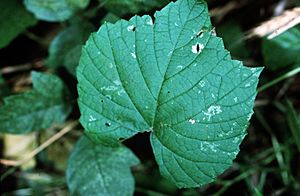Frost grape facts for kids
Quick facts for kids Frost grape |
|
|---|---|
 |
|
| Scientific classification | |
| Genus: |
Vitis
|
| Species: |
vulpina
|
| Synonyms | |
|
V. cordifolia Michx. |
|
The Frost Grape (also known as Vitis vulpina, winter grape, fox grape, or wild grape) is a type of vine that grows in North America. It belongs to the grape family. You can find it across much of the eastern and central United States and in the Canadian province of Ontario.
The name Vitis is Latin for "vine." The word vulpina means "fox-like." It's thought that foxes liked these grapes, which is why Linnaeus gave them this name. The common name, frost grape, comes from how the grapes taste. They are usually sour, but they become sweet after a frost. The frost grape is a tall, woody vine with a thick trunk and reddish tendrils. Both the grapes and the vine can be used for many things, from food to traditional remedies.
Contents
What Does the Frost Grape Look Like?
The frost grape vine can live for a long time and grows at a medium speed. It can reach a height of about 83 feet (25 meters). Even though it's called "Frost Grape," the plant doesn't do well in very cold weather below -23 degrees Fahrenheit (-30 degrees Celsius). The frost helps the grapes ripen and become sweeter, usually in September and October.
The Grapes
The grapes are small, round, and dark purple. They are very tart or sour at first. After a frost, they become sweet because their acid levels drop. If the grapes are not picked before winter, they can shrivel up on the vine, turning into raisins. These shriveled grapes are a good food source for animals during the colder months.
Flowers and Leaves
Frost grape vines can have either male and female flowers on the same plant, or separate male and female plants. Their flowers appear from May to June. The flowers grow in clusters and have 5 yellow petals.
The leaves grow one after another along the stem. They are shaped like a heart. Unlike some other wild grapes, the leaves of the frost grape do not have tiny hairs on them. Reddish tendrils grow opposite every third leaf. These tendrils help the vine climb along surfaces.
Where Does the Frost Grape Grow?
You can often find frost grapes in damp or dry soils. They like to grow in woods, flood plains (areas near rivers that can flood), and ravines (narrow valleys). Because the vine is good at climbing, people sometimes use it to grow along fences or trellises to decorate their gardens.
How Are Frost Grapes Used?
The grapes are safe to eat. People use them to make things like:
- Wine
- Jam
- Jellies
Parts of the plant are also used in traditional herbal medicines.

